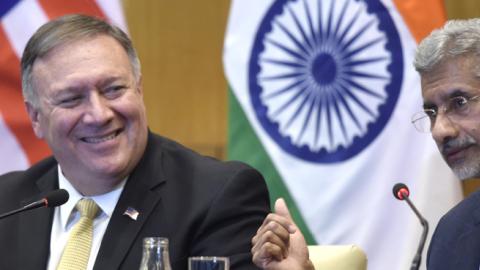India is busy explaining itself and its global aspirations to the world. Over the last several days, Prime Minister Narendra Modi and his External Affairs Minister Subrahmanyam Jaishankar have spoken to many foreign leaders, think tanks, and media outlets. But what has India really achieved through this whirlwind diplomacy other than attempting to allay foreigners’ concerns about developments in Kashmir and about Indian democracy? The fact that these concerns have emerged in the first place should be of greater concern to the managers of India’s foreign relations.
The effort to woo and impress foreigners, especially Americans, began with Prime Minister Modi’s ‘Howdy, Modi!’ event on 22 September in Houston. It was followed by bilateral and multilateral meetings on the sidelines of the UN General Assembly (UNGA) in New York and culminated with a three-day swing by S. Jaishankar in Washington DC.
According to news reports, in New York alone Jaishankar met from 42 countries, held three dozen bilateral meetings, eight pull asides, and seven pluri-laterals (meetings involving representatives of several countries), in addition to the meetings he attended with the Prime Minister. He also had three speaking engagements in New York.
In Washington DC, Jaishankar addressed public and private events at five US think tanks in addition to holding meetings at the US Department of State, the Department of Defense and the National Security Council.
Old India vs New India
The sheer intensity of this engagement is impressive. It was almost like 1949, when Prime Minister Jawaharlal Nehru spent three weeks in the US, hoping to introduce a newly independent India to Americans and develop a long-term partnership with what was then one of the world’s two superpowers.
But does the New India of today need to be introduced and explained the same way as Nehru explained ‘Old India’ to the Americans? Perhaps, there is something similar, notwithstanding the protestations about things being different. Indians still believe that India deserves to be at the global high table just by virtue of being India – a 5,000-year-old civilisation, with a rich culture and history.
There is still little effort to portray shared strategic or economic interests. Apart from repetition of India’s importance based on the size of its population, its strategic location, and its civilisational heritage, this time there was an added layer of pointing out how critics of India’s actions, including in Kashmir, simply do not understand India.
Seventy-two years after Independence, India has greater economic strength and enjoys far more strategic partnerships than it did in 1947. India is also fortunate to have an external affairs minister who understands the United States well, has spent time in Washington DC, including as an ambassador, and is articulate and well-spoken.
As Jaishankar knows well, Washington DC is a city with a short memory, and it is important to keep reiterating one’s viewpoint so that key stakeholders are in the know. But it is equally important to review the viewpoint and consider the concerns of others.
Can’t ignore US interests forever
Although the US and India were rarely on the same side during the Cold War, people-to-people ties ensured that when India finally liberalised its economy and expressed willingness to play a bigger role on the global stage, expectations were raised regarding a strategic partnership with the United States. That expectation has benefitted India, resulting in bipartisan support within the US system for India-US ties over the decades.
Today the relationship rests not just on 4 million (40 lakh) Indian-Americans, but also on the potential of strong economic ties and critical strategic partnership. India is a Major Defence Partner of the US, and New Delhi is at the heart of the American-led Indo-Pacific strategy to counter the rise of China.
Differing views on Iran, India’s desire to play a hedging or balancing game vis-à-vis China, and its purchase of Russian-made defence equipment, namely the S-400, are all sources of some tension in the relationship. Although India-US bilateral trade stands at $142 billion today, nationalist, protectionist sentiments and demands of domestic politics could undermine strategic convergence.
India’s phenomenal rate of economic growth over the last two decades made it an attractive partner for the US and many other countries. The slowing down of the economy will take away some of that allure. For example, the fact that Indians and Americans generally like each other cannot compensate for the absence of overlapping economic benefits. India cannot forever ignore US interests while repeating the mantra of both countries being democracies, having shared values, and being close friends.
Eventually, India would have to respond to America’s requests over trade policy, market access, and a level-playing field for US technology firms. Washington will be won, or lost, once India takes decisive action on American hopes of securing India’s commitment to confront China’s expansion in the Indo-Pacific.
Sharing Americans’ love for Gandhi
Moreover, the American affection for India stems from the admiration for the national characteristics that India’s current leaders seem committed to reversing. Mahatma Gandhi is the most popular Indian among Americans – a fact demonstrated by the Speaker of the House, Nancy Pelosi, who spoke at his 150th anniversary celebrations on the Hill and acknowledged by Modi through the article on Gandhi in the increasingly critical The New York Times on 2 October.
India would gain more support by reassuring The New York Times readers that leaders of New India share Americans’ love for Gandhi’s non-violence, support for diversity, and tolerance towards minorities.
Until those aspects of Indian policy, or lack thereof, which have started bothering some Americans are addressed, whirlwind diplomacy will only be able to create an air of extensive engagement. But it is unlikely to create the elusive strategic partnership everyone has been talking about for years.
Read in The Print



















